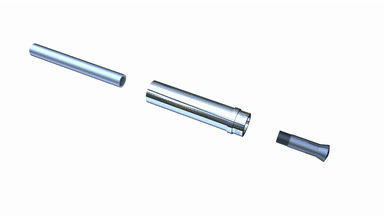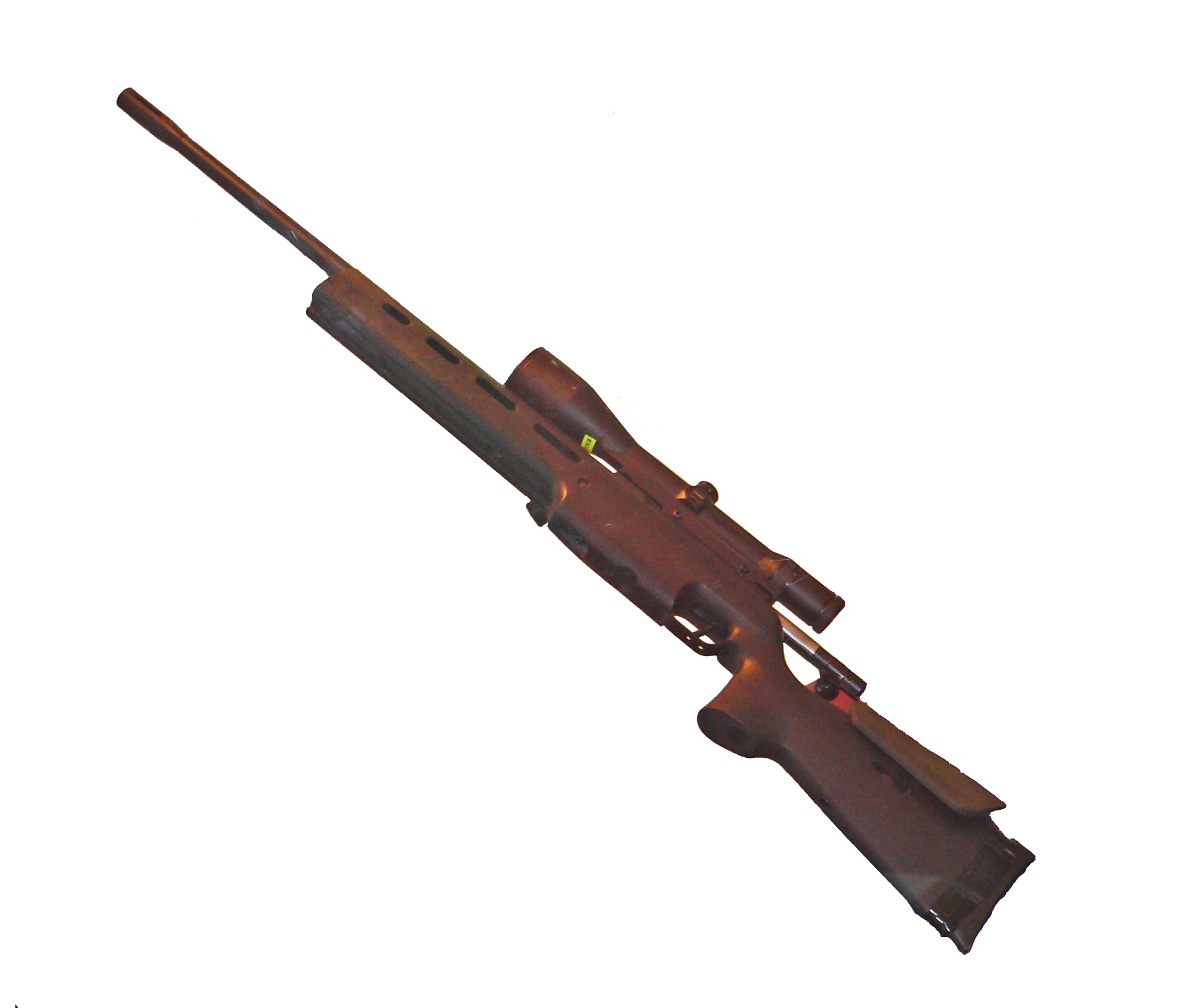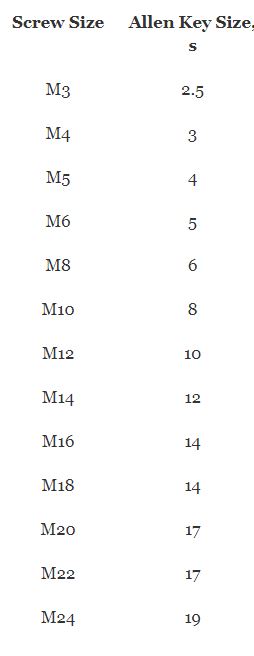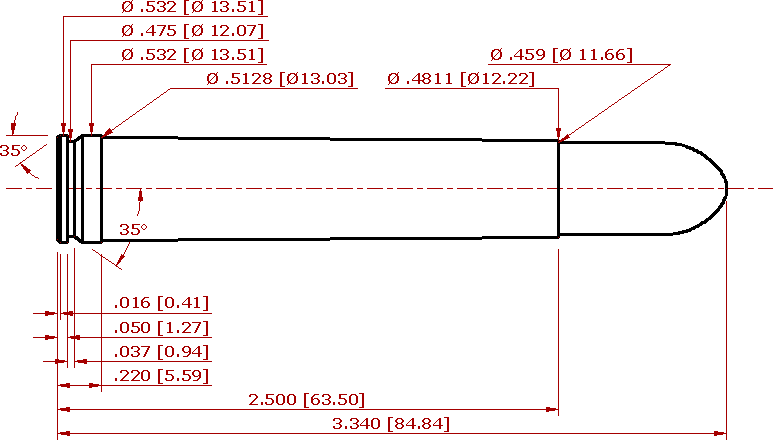|
Blaser R93
The Blaser R93 is a straight-pull action precision rifle offered in a multitude of calibers and barrel lengths manufactured by the German firearms manufacturer Blaser. Designed by Blasers' designer Mr. Meinhard Zeh in 1993, it had a number of features rare on modern hunting rifles, including a manual cocking system and a proprietary Blaser saddle scope mount for mounting the optic directly to the quick-change barrel In 2002, more than 100,000 complete Blaser R93 rifles had been produced. By 2017, more than 200,000 R93 rifles had been produced, but it is not clear whether the R93 Tactical variant is included in these numbers. History The predecessor of the R93 was the 60 degree turn bolt action Blaser R84, which was discontinued after the introduction of the R93 in 1993. The successor of R93, Blaser R8, was introduced in 2008. Production of the R93 ended around 2016/2017. Design features Modularity The Blaser R93 is a truly Modular weapon system, modular system bui ... [...More Info...] [...Related Items...] OR: [Wikipedia] [Google] [Baidu] |
Precision Rifle
A sniper rifle is a high-precision, long-range rifle. Requirements include accuracy, reliability, mobility, concealment and optics for anti-personnel, anti-materiel and surveillance uses of the military sniper. The modern sniper rifle is a portable shoulder-fired weapon system with a choice between bolt-action or semi-automatic action, fitted with a telescopic sight for extreme accuracy and chambered for a high-ballistic performance centerfire cartridge. History The Whitworth rifle was arguably the first long-range sniper rifle in the world. Designed by Sir Joseph Whitworth, a prominent British engineer, it used barrels with hexagonal polygonal rifling, which meant that the projectile did not have to bite into the rifling grooves as was done with conventional rifling. His rifle was far more accurate than the Pattern 1853 Enfield, which had shown some weaknesses during the recent Crimean War. At trials in 1857, which tested the accuracy and range of both weapons, Whitworth's ... [...More Info...] [...Related Items...] OR: [Wikipedia] [Google] [Baidu] |
Modular Weapon System
A modular weapon system (MWS) is any weapon equipment which has removable core components (or " modules") that can be reconfigured/interchanged to give the weapon different capabilities to adapt to various applications. Modularity can provide several advantages to military organizations, such as the versatility of allowing units to quickly tailor their weapons to best suit the immediate tactical needs, to quickly repair/exchange malfunctioned components, and to reduce overall logistical burdens and costs. However, it also make the legal tracking and technical categorization of a weapon more complicated as it can now be easily converted into a diverse variety of different forms.* For example, the Stoner 63 is a 5.56×45mm NATO-caliber modular small arm system using a variety of modular components, which can be configured as a rifle, a carbine, a top-fed light machine gun, a belt-fed squad automatic weapon, or a vehicle mounted weapon. A modular firearm can also be useful fo ... [...More Info...] [...Related Items...] OR: [Wikipedia] [Google] [Baidu] |
Collet
A collet is a segmented sleeve, band or ''collar''. One of the two radial surfaces of a collet is usually tapered (i.e a truncated cone) and the other is cylindrical. The term ''collet'' commonly refers to a type of chuck that uses collets to hold either a workpiece or a tool (such as a drill) but has other mechanical applications. An external collet is a sleeve with a cylindrical inner surface and a conical outer surface. The collet can be squeezed against a matching taper such that its inner surface contracts to a slightly smaller diameter, squeezing the tool or workpiece to hold it securely. Most often the collet is made of spring steel, with one or more kerf cuts along its length to allow it to expand and contract. This type of collet holds the external surface of the tool or workpiece being clamped. This is the most usual type of collet chuck. An external collet clamps against the internal surface or bore of a hollow cylinder. The collet's taper is internal and th ... [...More Info...] [...Related Items...] OR: [Wikipedia] [Google] [Baidu] |
Zeiss Rail
Zeiss inner rail,ZEISS Hunting Catalogue 2018 "ZEISS revolutionised riflescope mounting? The introduction of the ZEISS inner rail in 1990 meant that gunsmiths no longer needed to perform the laborious tasks of gluing and drilling the mounting components to attach them to the riflescope. Since the patent expired in 2008, the ZEISS inner rail is now offered by almost all prominent European manufacturers." generally simply referred to as Zeiss rail, is a ringless mounting system introduced by |
Carl Zeiss AG
Carl Zeiss AG (), branded as ZEISS, is a German manufacturer of optical systems and optoelectronics, founded in Jena, Germany in 1846 by optician Carl Zeiss. Together with Ernst Abbe (joined 1866) and Otto Schott (joined 1884) he laid the foundation for today's multi-national company. The current company emerged from a reunification of Carl Zeiss companies in East and West Germany with a consolidation phase in the 1990s. ZEISS is active in four business segments with approximately equal revenue (Industrial Quality and Research, Medical Technology, Consumer Markets and Semiconductor Manufacturing Technology) in almost 50 countries, has 30 production sites and around 25 development sites worldwide. Carl Zeiss AG is the holding of all subsidiaries within Zeiss Group, of which Carl Zeiss Meditec AG is the only one that is traded at the stock market. Carl Zeiss AG is owned by the foundation Carl-Zeiss-Stiftung. The Zeiss Group has its headquarters in southern Germany, in the ... [...More Info...] [...Related Items...] OR: [Wikipedia] [Google] [Baidu] |
17 HMR
.17 Hornady Magnum Rimfire, commonly known as the .17 HMR, is a rimfire rifle cartridge developed by Hornady in 2002. It was developed by necking down a .22 Magnum case to take a .17 caliber (4.5 mm) projectile. Commonly loaded with a 17 grain (1.1 g) projectile, it can deliver muzzle velocities in excess of 775 m/s (2,650 ft/s). Development The .17 HMR round is similar to rounds developed by dedicated rimfire wildcatters who worked to create a rimfire cartridge with an exceptionally flat trajectory. These wildcatters were seeking to match the ballistics of the obsolete 5mm Remington Rimfire Magnum, which was made from 1970 to 1974, and was to that point the fastest rimfire cartridge ever produced. With 5 mm diameter barrels and bullets being virtually unavailable at the time (the 5mm RMR was the last commercial 5 mm round until the 2004 release of the centerfire .204 Ruger), the commercially available .17 caliber became their bullet of choice. The .22 Wi ... [...More Info...] [...Related Items...] OR: [Wikipedia] [Google] [Baidu] |
22 Long Rifle
The .22 Long Rifle or simply .22 LR or 22 (metric designation: 5.6×15mmR) is a long-established variety of .22 caliber rimfire ammunition originating from the United States. It is used in a wide range of rifles, pistols, revolvers, smoothbore shotguns, and submachine guns. In terms of units sold it is by far the most common ammunition in the world today. Common uses include hunting and shooting sports. Ammunition produced in .22 Long Rifle is effective at short ranges, has little recoil, and is cheap to purchase, making it ideal for training. History American firearms manufacturer J. Stevens Arms & Tool Company introduced the .22 Long Rifle cartridge in 1887. The round owes its origin to the .22 BB Cap of 1845 and the .22 Short of 1857. It combined the case of the .22 Long of 1871 with a bullet, giving it a longer overall length, a higher muzzle velocity and superior performance as a hunting and target round, rendering the .22 Extra Long cartridges obsolete. The . ... [...More Info...] [...Related Items...] OR: [Wikipedia] [Google] [Baidu] |
Hex Key
Hex keys of various sizes Socket head screws of various sizes A hex key (also, hex wrench, Allen key and Allen wrench) is a simple driver for bolts or screws that have heads with ''internal'' hexagonal recesses (sockets). Hex keys are formed from a single piece of hard hexagonal steel rod, having blunt ends that fit snugly into similarly-shaped screw sockets. The rods are bent to 90º, forming two arms of unequal length resembling an "L". The tool is usually held and twisted by its long arm, creating a relatively large torque at the tip of the short arm; it can also be held by its short arm to access screws in difficult-to-reach locations and to turn screws faster at the expense of torque. Hex keys are designated with a socket size and are manufactured with tight tolerances. As such, they are commonly sold in kits that include a variety of sizes. Key length typically increases with size, but not necessarily proportionally so. Variants on this design have the short end i ... [...More Info...] [...Related Items...] OR: [Wikipedia] [Google] [Baidu] |
Gauge (firearms)
The gauge (or commonly bore in British English) of a firearm is a unit of measurement used to express the inner diameter (bore diameter) of the barrel. Gauge is determined from the weight of a solid sphere of lead that will fit the bore of the firearm and is expressed as the multiplicative inverse of the sphere's weight as a fraction of a pound, e.g., a one-twelfth pound lead ball fits a 12-gauge bore. Thus there are twelve 12-gauge balls per pound, etc. The term is related to the measurement of cannon, which were also measured by the weight of their iron round shot; an 8-pounder would fire an 8 lb (3.6 kg) ball. Gauge is commonly used today in reference to shotguns, though historically it was also used in large double rifles, which were made in sizes up to 2 bore during their heyday in the 1880s, being originally loaded with black powder cartridges. These very large rifles, called " elephant guns", were intended for use primarily in Africa and Asia for hunting large ... [...More Info...] [...Related Items...] OR: [Wikipedia] [Google] [Baidu] |
458 Winchester Magnum
The .458 Winchester Magnum is a belted, straight-taper cased, big five game rifle cartridge. It was introduced commercially in 1956 by Winchester and first chambered in the Winchester Model 70 African rifle. It was designed to compete against the .450 Nitro Express and the .470 Nitro Express cartridges used in big bore British double rifles. The .458 Winchester Magnum remains one of the most popular large game cartridges, and most major ammunition manufacturers offer a selection of .458 ammunition. History The .458 Winchester Magnum was designed for hunting dangerous game animals by emulating the performance of powerful English double rifle cartridges in a bolt-action rifle. The use of a bolt-action rifle offered hunters a cheaper alternative to the big-bore double rifle, and ammunition could be manufactured using available tooling. The .458 Winchester Magnum soon became a success as dangerous game hunters adopted the cartridge. Soon game wardens, wildlife managers, and prof ... [...More Info...] [...Related Items...] OR: [Wikipedia] [Google] [Baidu] |
416 Remington Magnum
The .416 Remington Magnum is a .416 caliber (10.57 mm) cartridge of belted bottlenecked design. The cartridge was intended as a dangerous game hunting cartridge and released to the public in 1989. The cartridge uses the case of the 8 mm Remington Magnum as a parent cartridge. When the cartridge was released in 1988, author Frank C. Barnes considered the .416 Remington Magnum to be the "most outstanding factory cartridge introduced in decades". The cartridge was conceived as a less costly alternative to the .416 Rigby cartridge and was intended to replace the latter. While today the .416 Remington Magnum is considered in the field the most popular of the .416 cartridges, the .416 Remington did not replace the .416 Rigby as had been anticipated. Rather, it sparked a renewed interest in the .416 caliber (10.57 mm) cartridges which led to the revival of the .416 Rigby and the introduction of other .416 cartridges such as the .416 Weatherby Magnum and the .416 Ruger. The ... [...More Info...] [...Related Items...] OR: [Wikipedia] [Google] [Baidu] |
375 H&H Magnum
__NOTOC__ Year 375 ( CCCLXXV) was a common year starting on Thursday (link will display the full calendar) of the Julian calendar. At the time, it was known as the Year after the Consulship of Augustus and Equitius (or, less frequently, year 1128 ''Ab urbe condita''). The denomination 375 for this year has been used since the early medieval period, when the Anno Domini calendar era became the prevalent method in Europe for naming years. Events By place Roman Empire * November 17 – Emperor Valentinian I concludes an enduring peace with the Alamanni in Germany, then marches into Illyricum to repel an invasion of the Quadi and the Sarmatians on the Danube frontier. While negotiating with the Quadi, Valentinian, age 54, becomes so enraged that he dies in a fit of apoplexy at Brigetio (Hungary). Extreme cruelty has marked his 11-year reign, but he has also founded schools and provided physicians to serve the poor of Constantinople. * The Quadi accept an uneasy ... [...More Info...] [...Related Items...] OR: [Wikipedia] [Google] [Baidu] |




.jpg)






